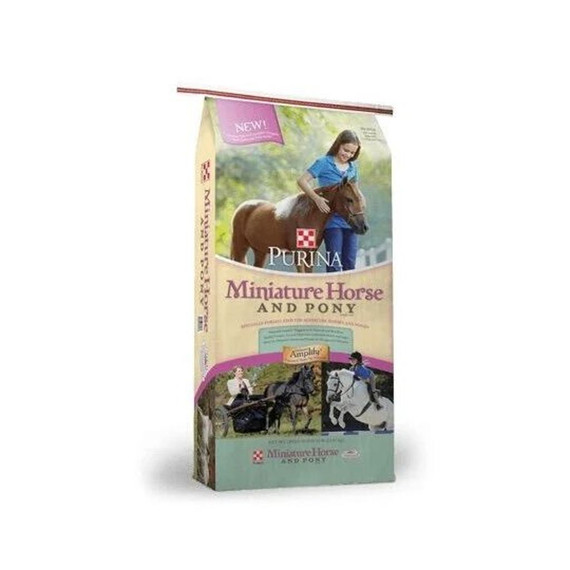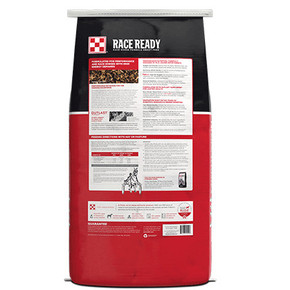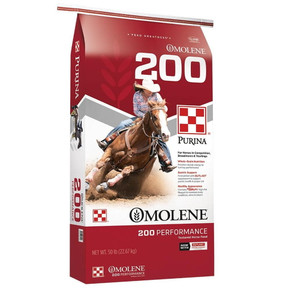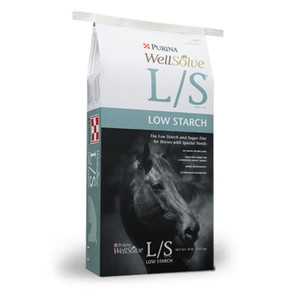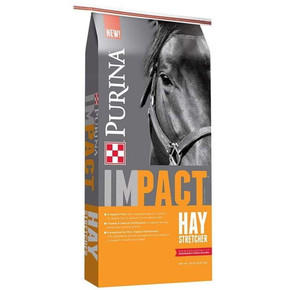
Purina Miniature Horse & Pony Feed - 50 lb
Purina Miniature Horse and Pony Horse Feed is specifically formulated to meet the unique needs of miniature horses and ponies who tend to be more metabolically efficient than large horses, but still require the nutrition necessary for growth, gestation, lactation, breeding, and competition.
Features
- Added beet pulp - Provides an excellent source of fermentable fiber for slow-release energy
- Concentrate feed - Designed to be fed with hay or pasture
- Controlled sugar and starch - May help reduce the risk of adverse health effects caused by the management error of overfeeding
- Highly digestible ingredients - Provide nutrient density and support proper digestion
- Highly palatable - Premium formulation made with the highest-quality ingredients
- High-quality protein - With a desirable amino acid profile to support strong muscle growth, shiny coat, and healthy hooves
- Nutritionally balanced - Provides 100% of the required nutrients for mini horses and ponies when fed as directed so no additional supplements are necessary. Based on "Nutrient Requirements Of Horses Sixth Revised Edition 2007" published by the National Research Council
- Purina amplify high-fat nugget - A proprietary blend of vegetable oils, flaxseed, and rice bran for an optimal fatty acid profile to support strong immune function
Nutrients
- Crude Protein (min): 13.50 %
- Lysine (min): 0.80 %
- Crude Fat (min): 4.50 %
- Crude Fiber (min): 18.00 %
- Acid Detergent Fiber (ADF) (min): 23.00 %
- Neutral Detergent Fiber (NDF) (min): 39.00 %
- Starch (min): 11.00 %
- Sugars (min): 7.00 %
- Calcium (Ca) (min): 0.80 %
- Calcium (Ca) (min): 1.30 %
- Phosphorus (P) (min): 0.65 %
- Copper (Cu) (min): 75.00 PPM
- Selenium (Se) (min): 0.60 PPM
- Zinc (Zn) (min): 270.00 PPM
- Vitamin A (min): 6000 IU/LB
- Vitamin E (min): 125 IU/LB
Feeding Directions
Description
Feeding directions with hay or pasture. Start with the amounts given for the weight and lifestyle of the horse. After observing the horse for a period of time, the amount fed may be increased or decreased by 10% to obtain the desired body condition and weight.
*This is the recommended minimum amount of hay to be fed. If feeding more hay, reduce the feeding rate of miniature horse and pony feed by 0.5 lb for every pound of additional hay feed. Example using the chart above, if feeding 7 lb instead of 6 lb of hay to a 500 lb light working pony, reduce miniature horse and pony feed offered by 0.5 lb from 3.3 to 2.8 lb per day.
**Do not feed less than 0.3 lb per 100 lb of body weight per day. Example a 200 lb miniature horse has two 100 lb increments (200 divided by 100 = 2). So for this horse, do not feed less than 0.6 lb per day (2 X 0.3 = 0.6 lb per day). If your horse gains too much weight at that minimum feeding rate, then you should replace miniature horse and pony feed with enrich plus ration balancing feed or well solve w/c horse feed.
***If foal and mare are fed together, increase the amount offered by 0.25 lb per month of age (of the foal) per day for miniature horses, and 0.5 lb per month of age (of the foal) per day for ponies.
Best Results
- Feeding rates will vary with size, age, temperament, health status, forage quality, climate, and activity level. Feed at regular times - At least twice daily with three daily feedings preferred. Let horses feed in a natural position from troughs with large bottoms, placed at normal head height or lower. Do not feed free choice. Prevent the rapid eating by the horse of any feedstuff
- Reduce and/or delay feeding a horse that is hot, excited, or showing pain, has a fever, or diarrhea. Consult your veterinarian if any problems arise
- Always feed a minimum of 1.0 to 1.2 lb per 100 lb of bodyweight of good quality, clean hay or the equivalent in pasture
- Any feed changes should be made gradually over a period of 7 to 10 days. Changes in the rate of feeding should not exceed 1.0 lb per day for each horse
- Have plenty of clean, fresh water available at all times. Provide your horse with access to salt. Maintain an effective control program for internal parasites. Have the horse's teeth examined annually and consult your veterinarian on a regular basis
Changing To
- Make the feed change gradually over a period of 7 to 10 days
- Mix the new feed with the old, gradually increasing the amount of the new feed while decreasing an equal amount of the old
Caution
Store in a dry, well-ventilated area protected from rodents and insects. Do not feed moldy or insect-infested feed to animals as it may cause illness, performance loss, or death.
Specifications
- Size: 50 Lb
- Life stage: Active pleasure, breeding & growing
- Type: Concentrate feed
- Form: Pelleted
Purina Miniature Horse and Pony Horse Feed is specifically formulated to meet the unique needs of miniature horses and ponies who tend to be more metabolically efficient than large horses, but still require the nutrition necessary for growth, gestation, lactation, breeding, and competition.
Features
- Added beet pulp - Provides an excellent source of fermentable fiber for slow-release energy
- Concentrate feed - Designed to be fed with hay or pasture
- Controlled sugar and starch - May help reduce the risk of adverse health effects caused by the management error of overfeeding
- Highly digestible ingredients - Provide nutrient density and support proper digestion
- Highly palatable - Premium formulation made with the highest-quality ingredients
- High-quality protein - With a desirable amino acid profile to support strong muscle growth, shiny coat, and healthy hooves
- Nutritionally balanced - Provides 100% of the required nutrients for mini horses and ponies when fed as directed so no additional supplements are necessary. Based on "Nutrient Requirements Of Horses Sixth Revised Edition 2007" published by the National Research Council
- Purina amplify high-fat nugget - A proprietary blend of vegetable oils, flaxseed, and rice bran for an optimal fatty acid profile to support strong immune function
Nutrients
- Crude Protein (min): 13.50 %
- Lysine (min): 0.80 %
- Crude Fat (min): 4.50 %
- Crude Fiber (min): 18.00 %
- Acid Detergent Fiber (ADF) (min): 23.00 %
- Neutral Detergent Fiber (NDF) (min): 39.00 %
- Starch (min): 11.00 %
- Sugars (min): 7.00 %
- Calcium (Ca) (min): 0.80 %
- Calcium (Ca) (min): 1.30 %
- Phosphorus (P) (min): 0.65 %
- Copper (Cu) (min): 75.00 PPM
- Selenium (Se) (min): 0.60 PPM
- Zinc (Zn) (min): 270.00 PPM
- Vitamin A (min): 6000 IU/LB
- Vitamin E (min): 125 IU/LB
Feeding Directions
Description
Feeding directions with hay or pasture. Start with the amounts given for the weight and lifestyle of the horse. After observing the horse for a period of time, the amount fed may be increased or decreased by 10% to obtain the desired body condition and weight.
*This is the recommended minimum amount of hay to be fed. If feeding more hay, reduce the feeding rate of miniature horse and pony feed by 0.5 lb for every pound of additional hay feed. Example using the chart above, if feeding 7 lb instead of 6 lb of hay to a 500 lb light working pony, reduce miniature horse and pony feed offered by 0.5 lb from 3.3 to 2.8 lb per day.
**Do not feed less than 0.3 lb per 100 lb of body weight per day. Example a 200 lb miniature horse has two 100 lb increments (200 divided by 100 = 2). So for this horse, do not feed less than 0.6 lb per day (2 X 0.3 = 0.6 lb per day). If your horse gains too much weight at that minimum feeding rate, then you should replace miniature horse and pony feed with enrich plus ration balancing feed or well solve w/c horse feed.
***If foal and mare are fed together, increase the amount offered by 0.25 lb per month of age (of the foal) per day for miniature horses, and 0.5 lb per month of age (of the foal) per day for ponies.
Best Results
- Feeding rates will vary with size, age, temperament, health status, forage quality, climate, and activity level. Feed at regular times - At least twice daily with three daily feedings preferred. Let horses feed in a natural position from troughs with large bottoms, placed at normal head height or lower. Do not feed free choice. Prevent the rapid eating by the horse of any feedstuff
- Reduce and/or delay feeding a horse that is hot, excited, or showing pain, has a fever, or diarrhea. Consult your veterinarian if any problems arise
- Always feed a minimum of 1.0 to 1.2 lb per 100 lb of bodyweight of good quality, clean hay or the equivalent in pasture
- Any feed changes should be made gradually over a period of 7 to 10 days. Changes in the rate of feeding should not exceed 1.0 lb per day for each horse
- Have plenty of clean, fresh water available at all times. Provide your horse with access to salt. Maintain an effective control program for internal parasites. Have the horse's teeth examined annually and consult your veterinarian on a regular basis
Changing To
- Make the feed change gradually over a period of 7 to 10 days
- Mix the new feed with the old, gradually increasing the amount of the new feed while decreasing an equal amount of the old
Caution
Store in a dry, well-ventilated area protected from rodents and insects. Do not feed moldy or insect-infested feed to animals as it may cause illness, performance loss, or death.
Specifications
- Size: 50 Lb
- Life stage: Active pleasure, breeding & growing
- Type: Concentrate feed
- Form: Pelleted

